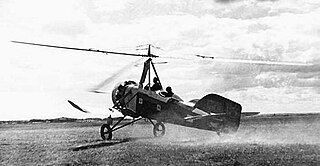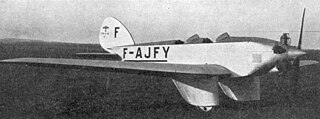| Fizir AF-2 | |
|---|---|
 | |
| Role | Two seat amphibian |
| National origin | Kingdom of Yugoslavia |
| Designer | Rudolf Fizir |
| First flight | 1930-31 |
The Fizir AF-2, Fizir 85 CV or Fizir-Vega was a two-seat amphibian intended for touring, sport and training.
| Fizir AF-2 | |
|---|---|
 | |
| Role | Two seat amphibian |
| National origin | Kingdom of Yugoslavia |
| Designer | Rudolf Fizir |
| First flight | 1930-31 |
The Fizir AF-2, Fizir 85 CV or Fizir-Vega was a two-seat amphibian intended for touring, sport and training.

The Fizir AF-2 was an amphibious flying boat with a wood framed, plywood covered, single step hull, stabilized on the water by a pair of sponsons. On its forward upper surface there was a tall, airfoil section, largely vertically sided column containing the cockpit and joining fuselage and the wing centre section. The cockpit contained two seats in tandem with the pilot in front [1] ahead of the wing leading edge and behind a vertical windscreen. He had two side windows, as did the passenger in the rear. An easily removable cabin top was available and dual controls could be fitted. [2] [3]
The AF-2 had a high, parallel chord, two part wing [1] with straight edges, semi-elliptical tips and about 6° of sweep. It had a largely wooden structure with twin box spars and was fabric covered. The wing was braced on each side with a pair of parallel, backward leaning, faired struts from the tips of the sponsons to the wing spars. A pusher configuration engine was mounted on the rear wing spar within a central rectangular wing cut-out, with its propeller disk immediately behind the wing trailing edge. The AF-2 fitted was an 63 kW (85 hp) Walter Vega five-cylinder radial engine, though there were plans to install other types in the 60–82 kW (80–110 hp) power range. [2] Its fuel tank was between the spars, immediately ahead of the gravity fed engine. [3]
The empennage was conventional, with a straight edged, blunt topped fin and rudder. The tailplane, semi-elliptical in plan, was mounted halfway up the fin, braced on each side with a pair of struts from the lower fuselage. The elevators had a small cut-out for rudder movement. These tail control surfaces were fabric covered steel structures. [2]
For use on land the AF-2 had independently mounted wheels, each between a pair of legs fitted with a shock absorber and hinged on a tube in the leading edge of the sponson. This arrangement enabled them to be raised by rotation, though still exposed, or lowered in fifteen seconds through a worm gear drive. There was a laminated tailskid. [2] [3]
The AF-2 probably first flew in late 1930 or early in 1931, though the exact date is not known and there are no further contemporary reports of its development in Flugsport or the major French and English journals.

Data from L'Aérophile April 1931, p.117 [2]
General characteristics
Performance

The TsAGI A-4, sometimes anglicised as CAHI A-4 or ZAGI A-4, was an early Russian autogyro, influenced by Cierva designs and delivered in small numbers to the Soviet Air Force in 1934.

The Potez 40 was a French three-engine, braced high-wing monoplane designed and built in response to a French government programme for colonial transport and policing aircraft duties.
The Potez 38 was a French single engine, eight or nine seat passenger aircraft flown in 1930. Only one was built.

The Caudron C.27 was a French biplane, a two-seat basic trainer which also competed successfully in the 1920s.
The Caudron C.22 was a French twin engine night bomber built in 1917. It did not reach production.

The Caudron Type O was a French single seat air racing biplane first flown in 1914.

The Les Mureaux 3 C.2 and Les Mureaux 4 C.2 were French two seat, parasol winged fighters, flown in 1927-8, which differed only in their engines. They were developed into near identical army co-operation types, the ANF Les Mureaux 130 A.2 and ANF Les Mureaux 131 A.2, in 1929-31.
The Villiers 26 was a French naval seaplane which used Handley Page slats to provide the wide speed range required for escort and patrol duties. It was tested, behaved satisfactorily but received no production order.

The Villiers IV or Villiers 4 was a French two seat naval floatplane. Two were built, the first with twin floats and the second with one. The first was short-lived but the second set several world and national records; it later became the Villiers XI.
The Buscaylet-de Monge 7-4 was a small, French, twin-boom aircraft without a fuselage, built in the mid-1920s to explore the characteristics of a proposed larger machine.

The Albert A-60 was a single engine, two seat, wooden sports monoplane designed and built in France in the early 1930s. Two were built and flown with three different engines.

The Caproni Ca.95 was a large, three engine, long range, heavy bomber prototype built in Italy in 1929. It could carry a 1,600 kg (3,500 lb) bomb load and had three defensive gun positions. Only one was built.
The Avia 60-MP was a French motor glider with a wing based on that of the Avia 32-E, an advanced training glider. It was intended as both an advanced trainer and as an atmospheric research aircraft.
The Peitz 101, aka Peitz Avionette, was a French, amateur-built, all-metal light aircraft, first flown during the winter of 1931–32.
The Renard R.33 was a Belgian training aircraft with aerobatic capability. Two were flown in 1934 but no more were produced.
The Morane-Saulnier MS.300 and MS.301 were French parasol wing introductory trainer aircraft, first flown in 1930. They differed only in engine type. Neither reached production but were developed into two similar trainers, the MS.230 and MS.315, which were made in large numbers.

The CAMS 80 was an amphibious reconnaissance flying boat flown in the early 1930s. Two were built with different engines and were used by the Aéronavale for VIP transport and equipment development until 1938.

The Dornier Do S was a large, 22-passenger flying boat airliner flown in Germany in 1930. Only one was built.
The Morane-Saulnier MS.152 was a French multi-purpose aircraft built in 1928. It did not go into production.

The Medwecki and Nowakowski M.N.5 was an economical Polish trainer aircraft initially aimed at the club market, though there was also some military interest. It performed well but lacked a constructor after Samolot became insolvent in 1930, so only one was completed.